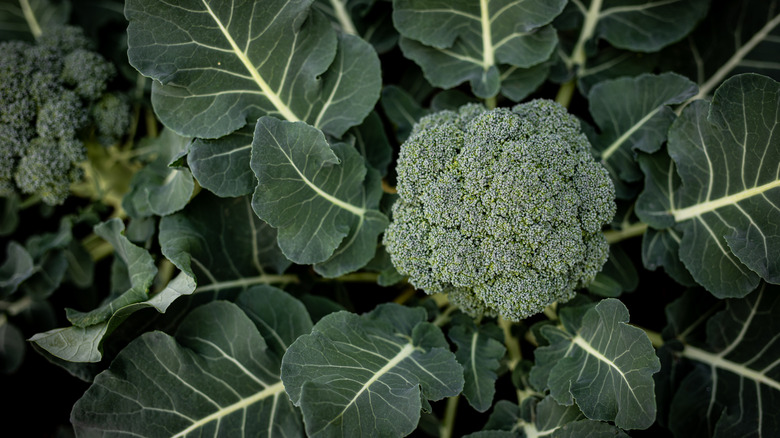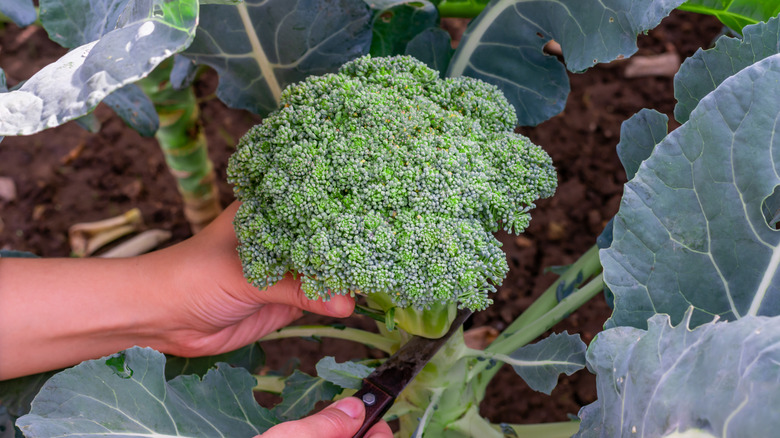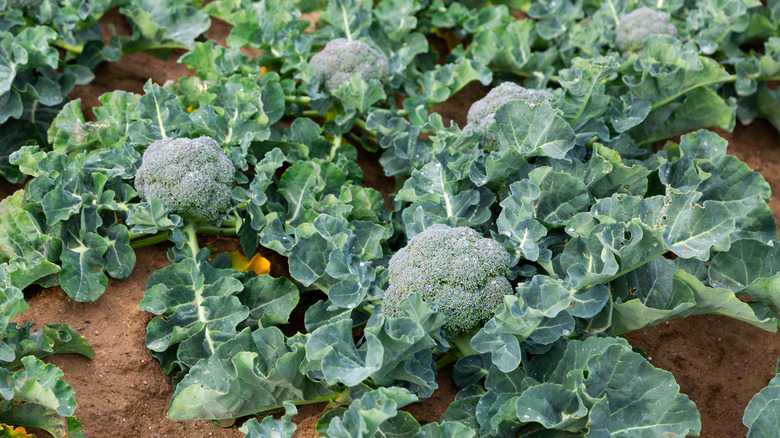The Gardening Tip That Prevents Mildew From Growing On Broccoli Plants
Growing on your own crops is an incredibly rewarding experience that provides joy and fulfillment all throughout the growing season. The best part, however, is harvesting ready-to-eat crops that you can include in your culinary endeavors in the kitchen. Nevertheless, developing good gardening habits is essential in order to foster healthy plants and to discourage pests and diseases from wreaking havoc in your garden. If you love growing broccoli, you probably already know that mildew can be a major heartbreaker when it comes to producing bountiful harvests. Mildew, particularly powdery mildew, thrives in conditions of high humidity, poor air circulation, and damp foliage. Regular monitoring for early signs of mildew and prompt intervention, such as removing affected leaves or applying fungicidal sprays, can also prevent its spread. Moreover, when harvesting the main head of broccoli, it's important to consider the side shoots by discouraging water from pooling on the harvested stump by cutting it properly.
By harvesting the main stems of broccoli properly, you can support the healthy growth of side shoots and discourage mildew from destroying future harvests. This practice is essential because mildew is detrimental to broccoli as it compromises the plant's ability to carry out photosynthesis, hindering its growth and reducing yield. Weakened plants are also more susceptible to other diseases and pests but also suffer from a decline in nutritional value and taste. If left untreated, mildew can escalate and lead to severe damage, potentially resulting in the loss of an entire broccoli harvest.
How to harvest broccoli to minimize mildew growth
To minimize water collection on broccoli florets and prevent mildew growth, it's important to adopt proper trimming techniques. When harvesting broccoli, cut the heads from the plant, leaving at least six inches of stem attached. This practice ensures that the plant remains healthy. After cutting, make a slanted or diagonal cut on the remaining stalk. The slanted cut prevents water from pooling and potentially causing rot at the center of a flat-cut stalk.
The slanted cut serves a dual purpose in preventing water accumulation and mildew growth. Unlike a flat cut, which can trap water and create a stagnant pool on the cut surface, the slanted cut promotes water runoff. This is particularly crucial for broccoli, as water pooling on the flowering heads can lead to mold formation on the delicate florets. By encouraging water to slide away from the cut, the slanted trimming method minimizes the risk of excess moisture collecting on the broccoli, creating an environment less favorable for mildew development.
Additionally, by leaving an ample stem length during the harvest, the plant continues to channel nutrients to the remaining foliage, allowing the plant to grow back and produce side shoots. This promotes overall plant health and resilience, further reducing the likelihood of mildew infestation. Proper trimming practices not only ensure the longevity of the broccoli plant but also play a key role in preventing the conditions conducive to mildew growth, contributing to a successful and healthy broccoli harvest.
Other ways to discourage mildew growth
While harvesting broccoli properly encourages healthy growth of side shoots and future harvests, there are additional strategies that you should pair with this practice in order to foster healthy plants. Proper spacing between broccoli plants, for example, is essential for promoting good air circulation. Crowded plants can create a humid microenvironment, facilitating mildew development. Maintaining recommended distances ensures that each plant has ample space for air movement, reducing the chances of moisture retention on leaves. Adequate spacing allows sunlight to reach all parts of the plant, promoting a drier and less favorable environment for mildew.
Secondly, watering plants at the base in the morning is a strategic practice that can also protect your broccoli from powdery mildew infections. Watering in the morning allows sufficient time for the leaves to dry during the day, minimizing the duration of leaf wetness. Mildew thrives in damp conditions, and by reducing the moisture on the foliage, gardeners can create an inhospitable environment for mildew spores to germinate and proliferate.
Lastly, removing and disposing of affected leaves promptly is a vital preventive measure that can be applied to all plants in your garden. If mildew is spotted on broccoli plants, removing the infected leaves prevents the spread of spores to healthy parts of the plant. Pruning away affected foliage also enhances air circulation within the plant, reducing the overall humidity and preventing mildew from establishing a foothold. Combined with the other gardening practices, this can effectively mitigate mildew issues.


